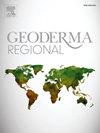A coupled model of greenhouse gas emissions from erosion and accretion prone zones of mangrove ecosystem, Sundarban, India
IF 3.3
2区 农林科学
Q2 SOIL SCIENCE
引用次数: 0
Abstract
Soil erosion (SE) and accretion process resulting from anthropogenic and natural causes has a substantial impact on soil quality and functionality, thereby influencing greenhouse gas (GHG) emissions. Here, the determination of the extent of SE, resultant accretion and emissions of GHGs like CO2, CH4, and N2O was quantified from the Sundarban mangrove ecosystem (SME). A Random Forest (RF) spatial model was proposed to predict the geographical distribution of GHG emissions throughout the Sundarban. Gas samples were gathered from the mangrove bed in 2022 using the enclosed box technique. Next, the Shuttle Radar Topographic Mission Digital Elevation Model (SRTM DEM), and Landsat 8 data were used to produce thematic inputs for the RUSLE model in a GIS platform. Both models were coupled to observe the match between erosion and GHG emission. The result showed that coastal most western part of Sundarban is prominent for CO2 (28.29–31.29 mmol m−2 d−1) and CH4 (0.281–0.329 mmol m−2 d−1) emission while N2O fluctuated more (0.137–0.169 mmol m−2 d−1) at central eastern part due to high deforested agriculture and aquaculture practices. The study revealed that the islands of Sundarban, located at the edge of the Bay of Bengal (BoB) have an increased risk of SE (>12 t ha−1 yr−1) as these islands encounter high oceanic water surges and cyclones yearly. The accuracy of the models were adjudged by the estimation of SE and GHG emission. The measured precision and area under the curve of receiver operating characteristics was 0.796 for RUSLE and 0.784 for RF models, respectively. An “Automated Linear Regression (ALR) model” showed that N2O was the most sensitive (Normalized Importance: 0.55) to erosion. Regression results showed association between GHGs and erosion were weakly correlated (R2 for CO2, CH4, and N2O were 54.79 %, 43.51 %, and 55.08 %). According to the “Artificial Neural Network (ANN) model, rainfall and runoff erosivity factor (R)” was the prime governing factor (normalized importance 100 %) for SE. The “RUSLE model” with “Coupled Model Intercomparison Project-6 (CMIP6)” “rainfall data”, a “Global Circulation Model (GCM)” and the historical climatic data from 1960 to 1989 revealed the CO2, CH4 and N2O emissions would be 7.13 %, 39.25 %, and 38.18 % respectively by 2100. Accretion phenomena was more on the upstream regions of the Sundarban estuary. The work will help the environmental managers in identifying the erosion-prone zones, thereby reducing the land cover changes for anthropogenic benefits that promoted SE.

印度孙德班红树林生态系统侵蚀和增生易发区温室气体排放的耦合模型
人为和自然原因导致的土壤侵蚀和土壤增积过程对土壤质量和功能产生重大影响,从而影响温室气体(GHG)排放。本文对孙德班红树林生态系统(SME)的SE、CO2、CH4和N2O等温室气体的累积和排放程度进行了量化。利用随机森林(RF)空间模型对孙德班地区温室气体排放的地理分布进行了预测。2022年,使用封闭箱技术从红树林床上收集了气体样本。接下来,利用航天飞机雷达地形任务数字高程模型(SRTM DEM)和Landsat 8数据为GIS平台中的RUSLE模型生成主题输入。将两个模型进行耦合,观察侵蚀与温室气体排放之间的匹配关系。结果表明,孙德尔本西部沿海地区CO2 (28.29 ~ 31.29 mmol m−2 d−1)和CH4 (0.281 ~ 0.329 mmol m−2 d−1)排放显著,中东部地区N2O波动较大(0.137 ~ 0.169 mmol m−2 d−1)。该研究表明,位于孟加拉湾(BoB)边缘的孙德班岛(Sundarban)由于每年都会遇到高海浪和气旋,因此东南风的风险增加(>;12吨/年−1年−1年)。通过估算SE和GHG排放量来判断模型的精度。RUSLE模型的测量精度为0.796,RF模型的测量精度曲线下面积为0.784。“自动线性回归(ALR)模型”显示N2O对侵蚀最敏感(归一化重要性为0.55)。回归结果显示,温室气体与侵蚀呈弱相关(CO2、CH4和N2O的R2分别为54.79%、43.51%和55.08%)。根据“人工神经网络(ANN)模型”,降雨和径流侵蚀因子(R)是SE的主要控制因子(归一化重要性为100%)。“RUSLE模式”与“耦合模式比对项目-6 (CMIP6)”的“降雨资料”、“全球环流模式(GCM)”和1960 - 1989年的历史气候资料显示,到2100年,CO2、CH4和N2O的排放量分别为7.13%、39.25%和38.18%。孙达尔班河口上游地区多为吸积现象。这项工作将有助于环境管理者确定易受侵蚀的地区,从而减少土地覆盖的变化,从而促进东南地区的人为利益。
本文章由计算机程序翻译,如有差异,请以英文原文为准。
求助全文
约1分钟内获得全文
求助全文
来源期刊

Geoderma Regional
Agricultural and Biological Sciences-Soil Science
CiteScore
6.10
自引率
7.30%
发文量
122
审稿时长
76 days
期刊介绍:
Global issues require studies and solutions on national and regional levels. Geoderma Regional focuses on studies that increase understanding and advance our scientific knowledge of soils in all regions of the world. The journal embraces every aspect of soil science and welcomes reviews of regional progress.
 求助内容:
求助内容: 应助结果提醒方式:
应助结果提醒方式:


